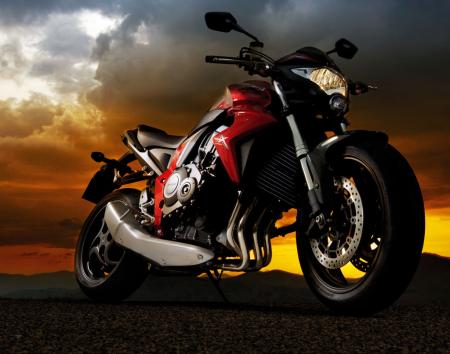
When Honda discontinued the 919 in 2007 (known as the Hornet 900 across the Atlantic), Europeans saw the gap filled with the higher-performance and futuristically styled CB1000R for the 2008 model year, but the machine failed to make it into North America.
We recently had a chance to sample the 2010 CB1000R at Roebling Road Raceway, as a teaser courtesy of Honda Canada, the distributor of Honda motorcycles north of the U.S. border. Lengthy Canadian winters prevent us Canuck journalists from riding until sometime in mid-April, so Honda Canada invited some of us to ride a slew of new Hondas (some of them Canadian-market only models like the CBF600 and CBF1000, which you’ll read about soon here on Motorcycle.com) in the more temperate climate of Savannah, Ga.
Honda Canada brought the CB1000R into the country for testing, with the possibility of offering it in its lineup in the not-too-distant future.
This sharply styled, liter-class naked bike is powered by a 998cc inline-Four sourced from the ’06-’07 CBR1000RR. Being a longer-stroke engine than the one available in the latest CBR, its potential for stronger midrange torque makes it better suited for naked-bike duties.
To emphasize a broader spread of torque, the CB uses 36mm throttle bodies as opposed to the ’07 CBR’s 44mm (the current CBR uses 46mm throttle bodies). Its compression ratio was reduced to 11.2:1 from 12.2:1.
In this detuned form the CB1000R’s engine produces a claimed 123 crankshaft horsepower at 10,000 rpm, a substantial reduction from the older CBR’s claimed 170 but still satisfying considering this isn’t a bike destined for the starting grid of a World Superbike race.
Torque peaks at 73 ft-lbs at 7750 rpm, and although the CB doesn’t have the brute bottom-end grunt of a Triumph Speed Triple, it does have a meaty midrange that gets progressively stronger as revs reach the 10,000 rpm redline. It has a satisfyingly flat powerband that won’t threaten to pop your shoulders when you twist the throttle to its stop. I saw about 150 mph on the digital speedo riding into a headwind along the front straight, and the bike was still pulling. The lack of bodywork, however, made holding on at that speed a real workout on the forearms and biceps.
Its six-speed gearbox operates so smoothly that it almost shifted at the mere thought of changing gears.
A single-backbone, gravity-cast aluminum frame uses a fully adjustable 43mm inverted fork, and a single-sided swingarm is suspended by a single shock adjustable for rebound damping and spring preload. Suspension settings as delivered were entirely up to the task of fast lapping of the mostly smooth, flowing racecourse, so occasional track-day aficionados won’t be disappointed with this machine.
Steering geometry is a bit less aggressive than on the latest CBR1000RR (25-degree rake, 3.9 inches trail vs. 23 degrees and 3.8 inches) and the wheelbase is stretched almost an inch and a half to 56.9 inches, but the bike still felt a bit twitchy through Roebling’s long, sweeping turns. That twitchiness was caused mostly by the leverage provided by the wide, 1980s superbike-bend handlebar. Despite lacking a steering damper, the bike gave no indication that it was prone to wobble.
Turn-in is quick enough to give the impression we were riding a middleweight roadster (claimed wet weight for the ABS model I rode is 489 pounds), and there is enough cornering clearance to ride to the edges of the Bridgestone BT-015 radials (same as on some U.S.-spec CBRs), with only the extra-long footpeg feelers bearing the brunt of hard lapping.
The seating position is typical of a naked bike, with footpegs mounted rearward, and somewhere between a supersport and sport-touring bike in height, and the handlebar places your body in a modest forward lean — in other words, just right for back-road blitzing. The bike feels relatively slender between the legs and its 32.5-inch seat height allows a flat-footed reach to the ground with a slight bend at the knees (I’m six feet tall).
A compact instrument panel is all LCD and includes the usual array of info including tripmeters, speed, clock and a bar tachometer. Despite its rather low placement it was easy to read, though I’d have preferred a round analog tach—call me old fashioned. The plus side of this dashboard is that it makes for a sleek nosepiece when viewed from the front.
Honda’s Combined ABS uses standard-mount three-piston front calipers squeezing 310mm rotors (radial-mount calipers are used on the non-ABS version) and a twin-piston rear caliper on a 256mm rotor. The brakes require higher lever effort to slow the bike hard than it would on a supersport machine, but effort is still well within sportbike standards and feedback is precise.
The CB1000R’s racetrack handling alone won me over, but where it will really shine is on the street. I decided to give the CB a break and rode one session at a sporting street pace and this naked roadster returned the favor by exhibiting a gentle demeanor and remaining nearly buzz-free at 65 mph.
A 4.5-gallon fuel tank should provide a decent range at legal speeds, and its Euro-inspired styling (the bike was designed by Honda’s R&D department in Rome) is stylishly futuristic without being an attack on the visual senses like Kawasaki’s new Z1000. To visually reinforce its CBR-RR lineage, it borrows styling cues from its sportier brother, including its low-slung angular exhaust and abbreviated tailpiece.
Where the CB1000R will feel most at home is in an urban setting or when blazing back roads with your riding buddies. Europeans know this, as the CB1000R has proven a popular mount across the pond.
Maybe North Americans will be as receptive to this sporty roadster, should it finally reach our shores. And that just might happen. With the bike being currently tested in the land of the maple leaf, it’s certainly one step closer.








































0 comments:
Post a Comment